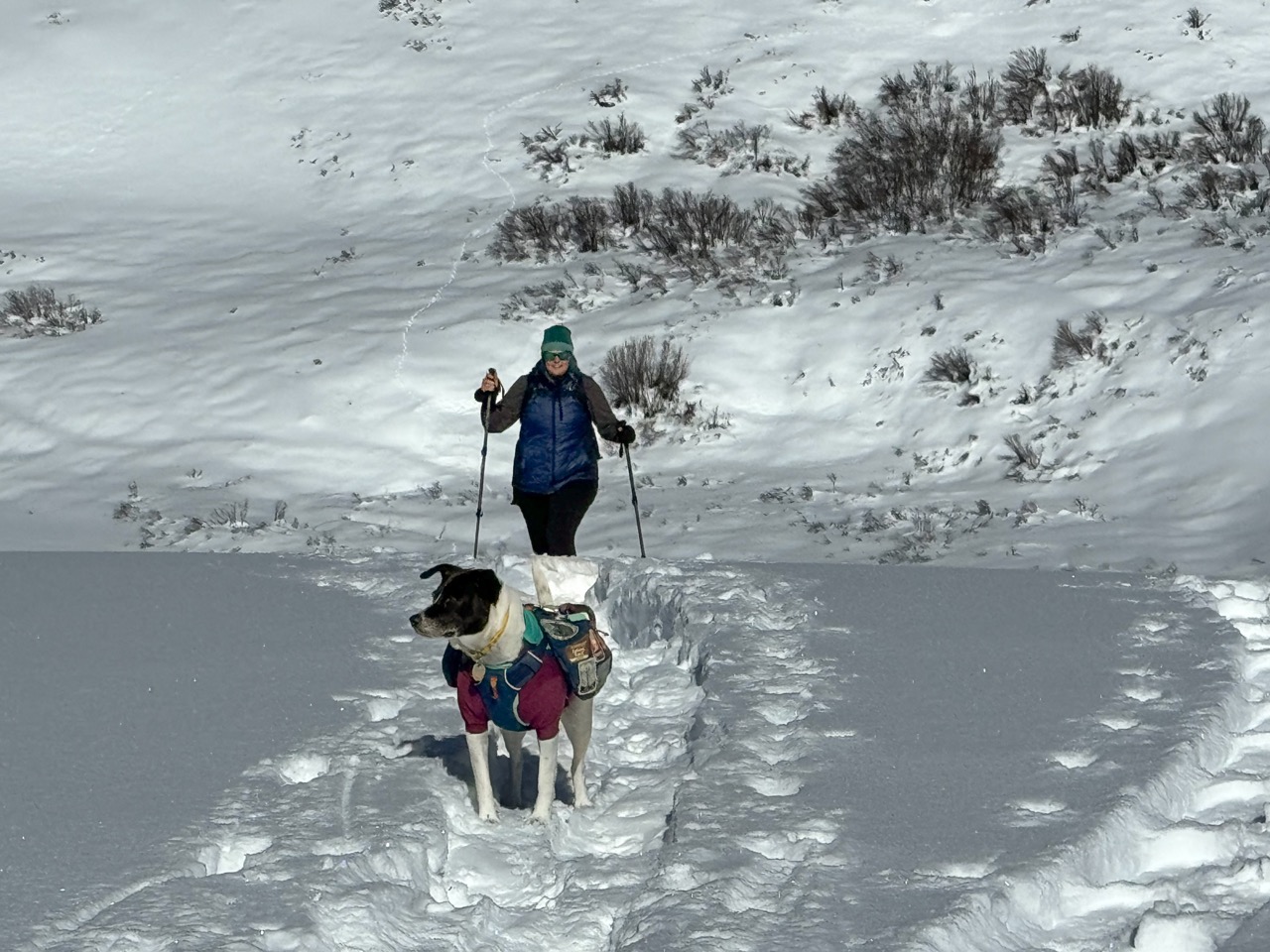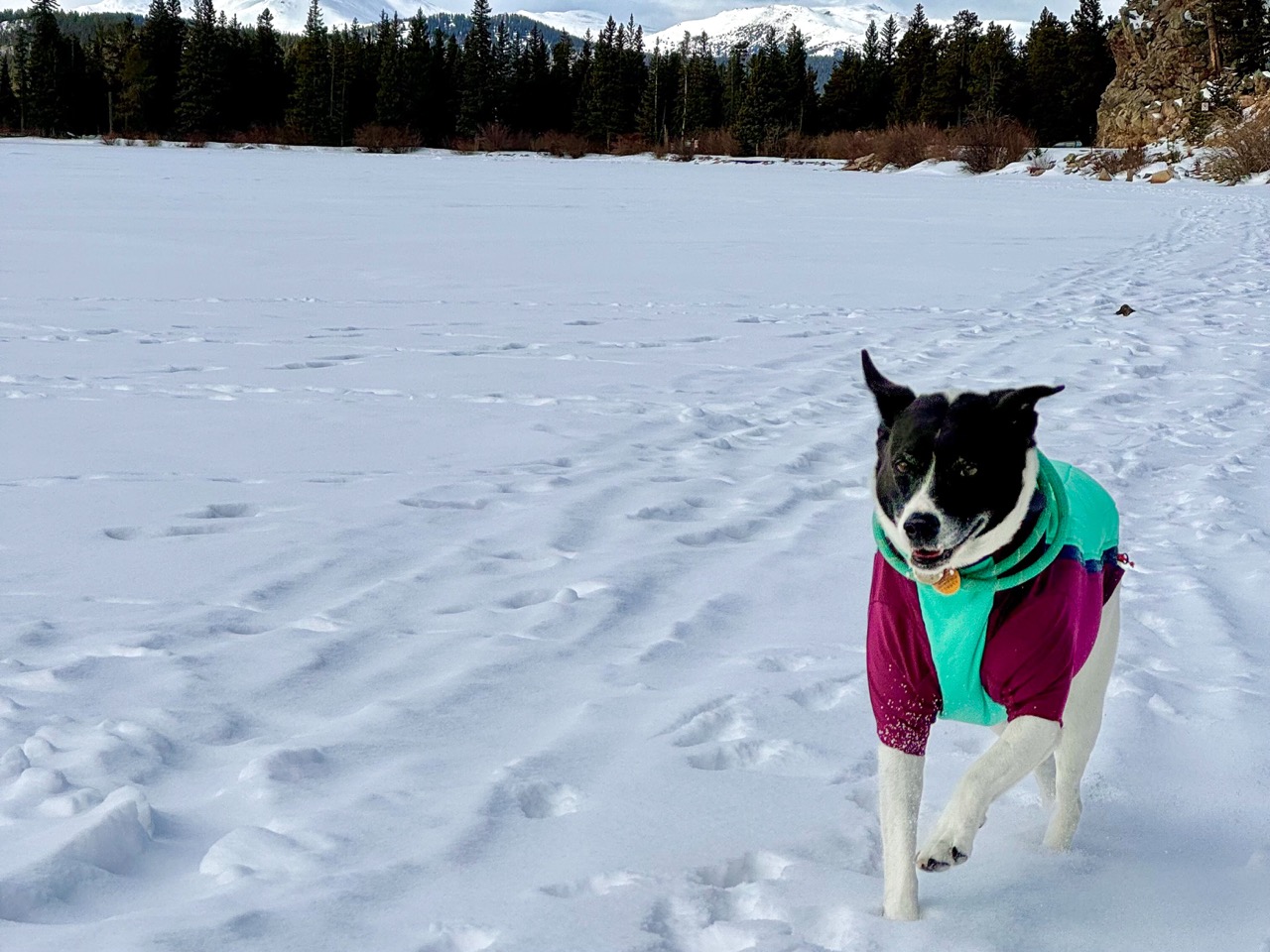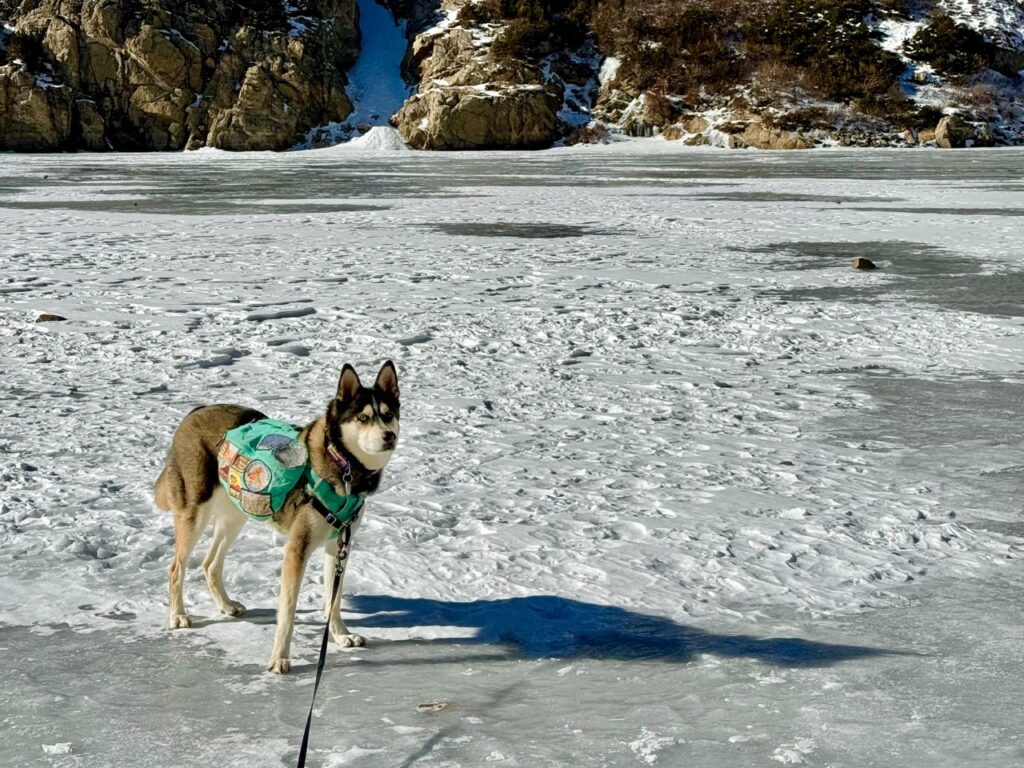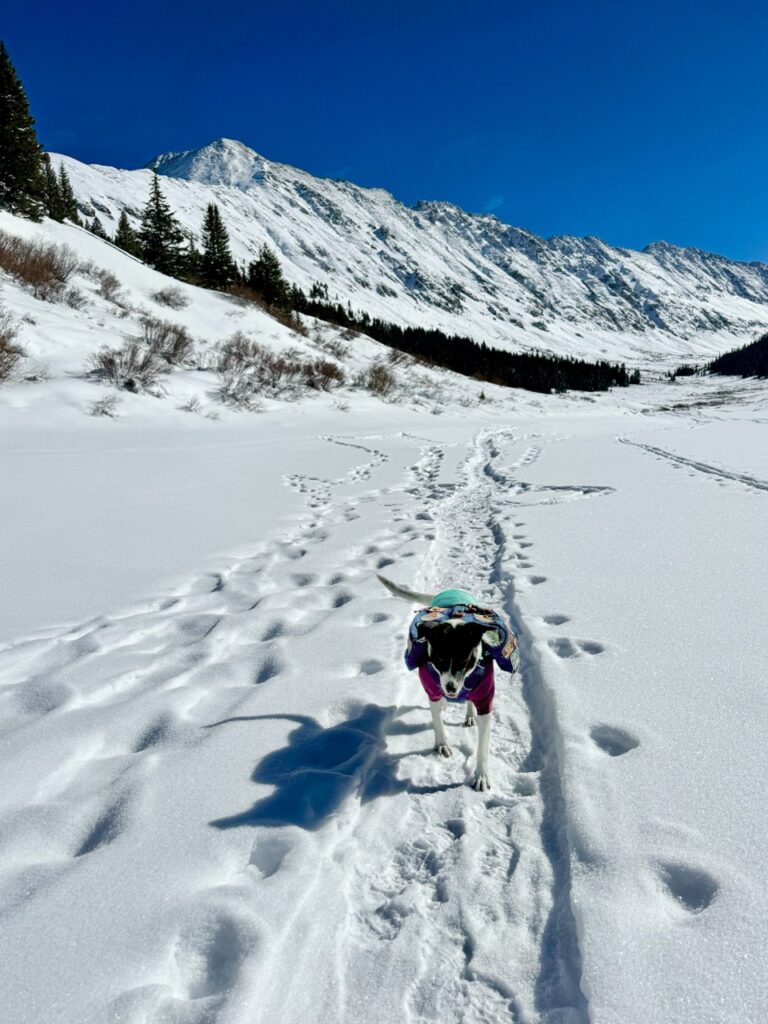Beginner’s guide to winter hiking with your dog: Snow pups unite!
There’s a lot to love about hiking in the winter with your dog, but if you’re a beginner to the notion, there are a few things to learn and know. Luckily, the learning curve is very low. The following information is based on what we’ve learned hiking in Colorado in the winter, but I think it can be applied to any cold weather landscape – flat or mountainous, continuously or occasionally snowy and icy.
This site contains affiliate links, which means when you click, we may receive a small commission from your purchase at no additional cost to you. This helps us run this page and offer great content free of charge, and we only recommend products that we use and love. We appreciate you!

Once you brush up on everything you need to know, check out our favorite winter trails:
- Hiking in a winter wonderland: 10 dog-friendly trails along Colorado’s Front Range
- Rocks rock: 10 dog-friendly geologic wonder hikes along Colorado’s Front Range (Perfect for fall & winter)
Everything to love about winter hiking
Few experiences are quite as sweet as taking your dog for a romp through a winter landscape. But I haven’t always felt that way. Personally, I only started winter hiking a few years ago. I moved to Colorado to ski many moons ago, and that was the activity that I have historically planned my winter life around. But when we adopted Ada as a puppy in 2021, she needed constant exercise and stimulation, and that didn’t dissipate in the winter.
In addition, I’ve struggled with seasonal depression & anxiety all my life. When winter hits, and the nighttime comes painfully early each day, my body and brain just revolt. My energy dips, my mood feels darker, and I worry more. Life feels harder, less rewarding, and more punishing. Skiing was always my winter outlet for being active, but it’s also challenging in Colorado – Heavy traffic, pricey lift tickets & equipment, and the slog of getting from front door to chair lift is intense.
I’ll never NOT love skiing, but when I realized that I needed to figure out a winter outlet for Ada, it also provided a perfect opportunity to recalculate my relationship with winter overall. I also wanted to make a concerted effort to appreciate winter, rather than dread it each year. And it turned out that winter hiking is an incredible vehicle for accomplishing all of these goals.
I never felt excited before by the prospect of winter hiking – The colors are duller, the light is sparser, and the wildflowers I love are napping. But through this personal initiative, I learned there are so many hidden benefits!
- More solitude – Fewer people take advantage of outdoor spaces in the winter, so parking is easier, and you’re likely to encounter fewer folks out on the trails.
- Less sweatiness – With the right layering strategy, you can retain your body heat, while also never feeling hot or sweaty
- Extremely beautiful ways to connect with the affordances of the season – Winter offers the chance to focus on the things that summer vibrancy overpowers, like rock formations, ice formations, evergreen landscapes, beautiful sunsets.
When I started winter hiking, however, it took me a while to really feel fully comfortable. It’s really just as easy to figure out as summer hiking. But to me it just felt more intimidating. It seemed like it had a higher learning curve. And for sure there are a few things you have to prepare for differently, and a few things to know that you simply aren’t necessary to consider in the warm months. So I bumbled around in the first year of winter hiking a little bit. But thanks to chatty REI employees, and a lot of googling, I quickly learned what I needed to know.
Now winter hiking with Bonnie & Ada is one of my favorite things. I genuinely look forward to the cold weather each year, and I have so much appreciation for the process of seeking and connecting with what makes winter unique and beautiful – When I stop to appreciate the insulated silence of a snowy landscape, and hear a chickadee cracking open a seed. When I get to watch my little husky Ada bound through deep snow banks and stick her face into the snow over and over again. When we descend down a rocky gulch, and discover rivulets of ice forming a veritable frozen beaded curtain adorning the rock. When I get to watch Bonnie bundled up in her warm winter jacket, rolling around with abandon in the snow.
In order to support others who are interested in beginning the journey of winter hiking, the following tips are based on the things I found most helpful to know and learn at the beginning of my journey.

The difference between snowshoeing and hiking
Understanding the difference between snowshoeing and winter hiking was one my biggest mental hurdles when I began winter hiking. I had never snowshoed before, so didn’t understand how it worked. I didn’t understand when I could just hike, and when I needed snowshoes.
Winter hiking and snowshoeing both allow people to explore snowy landscapes, but they differ in technique and equipment. Winter hiking is simply hiking on snow-covered trails, often using regular hiking boots or boots with added traction devices, like microspikes, to prevent slipping. (Microspikes will be explained in the next section) It typically works best on packed or shallow snow. Snowshoeing, on the other hand, uses specialized snowshoes that distribute weight more widely, allowing hikers to walk on deep, powdery snow without sinking in. While winter hiking is best for well-traveled or compacted paths, snowshoeing opens up more freedom to explore deeper, untouched snow where regular hiking would be difficult.
Bottom line, the distinction is easy:
- Snowshoeing: If you’re heading to a trail after a fresh, deep snow, OR heading somewhere where you want to forge your own trail, grab your snowshoes.
- Hiking: If you’re heading to an established trail where people hike frequently enough for the snow to stay packed down and/or icy, all you need are microspikes.
Alltrails reviews are an incredible tool to use to figure out if people have been hiking a trail, and the likelihood that the snow will be packed down. However, when I first started winter hiking, I would always bring snowshoes in addition to my regular hiking gear, so I would have the option to switch gears if the terrain didn’t turn out the way I expected.
How to snowshoe
Another misconception I worked through when I started winter hiking is understanding that snowshoeing takes no real technical skill or learning. Growing up both alpine and cross country skiing, I placed snowshoeing in the same category – Special equipment equals a learning curve. This is not really the case, however. Snowshoes are special equipment, but they require no lessons or special know-how to use. They’re simply a device that makes walking across deep snow possible.
The majority of this post focuses on winter hiking, or what I consider to be regular hiking with the addition of some micro-spikes for traction. However, I do want to share briefly how to snowshoe so you have this option as well.
In short, snowshoeing is a simple, accessible way to walk through deep snow by distributing your weight across the surface. To get started, strap snowshoes onto your boots, ensuring they’re securely fastened. Begin walking by lifting each foot slightly higher than usual to clear the snowshoe and avoid dragging. Take wider steps to prevent stepping on the sides of your snowshoes, which helps maintain balance. Use trekking poles for added stability, especially on slopes or uneven terrain. Start with a slow pace to get used to the movement, and remember to lift your feet fully with each step. Snowshoeing is all about pacing yourself and enjoying the winter scenery!
Snowshoes: Rent or buy?
Of course the answer to this question depends on your budget and your goals, but here are a few thoughts
- Many ski shops, plentiful in Colorado, rent snowshoes, which makes renting an excellent option for trying them out.
- I now own snowshoes so I have the option to use them anytime, and we do quite often. But if you only plan to snowshoe once or twice in a season, renting is lla perfectly fine option long term.
- It’s important to know that snowshoes are MUCH less technical than skis or snowboards. A lot of brands make them, and in my humble opinion, there’s not a ton of difference, as long as you buy the proper size for your height and weight. I personally prefer the metal framed ones, but mine are on the cheaper end. Of course if you plan to do lots of snowshoeing, and plan to travel long distances, you might want to invest in a more technical pair. But if you’re just getting started, don’t let yourself get lost in decision-making. But some that are on sale, and hit the trails!

Winter trail selection
A key to enjoying winter hiking as its own activity, rather than as a duller substitute for warm weather hiking, is to be really intentional about your trail selections. Choose trails that offer something unique, something you wouldn’t go for in the summer, or something that is transformed by the cold and/or snow. The following considerations can all help you make choices that keep your winter hiking adventures exciting and extraordinary.
- Hiking through snow or ice takes a little more effort. So we suggest shorter, flatter trails.
- Since winter trails tend to be more empty, we like to pick popular stunners – The trails we avoid in the summer because of crowds. Winter’s a great time to hit those state, city, county parks that are too hectic to bother with in the warmer months.
- If possible, we suggest choosing trails that have cell service. Because there are fewer people around, the cold weather makes any accidents more risky. If you do head somewhere without service, always tell someone where you’re going, and an estimated time you’ll be home so they can check on you.
- Seek things that winter can elevate. A frozen waterfall is pure magic. A frozen lake means you can walk along the surface, and to the distant shores you can’t access in the summer. (Only if you’re confident about the stability of the ice! We stick to walking on lakes where folks are ice fishing, since ice fishing necessitates a certain expertise about ice thickness)
- Seek things that stand out more when not surrounded by summer foliage. For example – Giant old trees, rock formations, historic structures, aging ruins, stunning sunsets, etc. These are all super fun to explore, especially in the snow!
Dressing for success
Layers are essential for any cold weather adventure, both for pups and for people! With the right layers, you’ll find winter hiking to be accessible and fun. Be willing to experiment a little, and you’ll have a great time.

Layering for humans
- First and foremost, you have to know yourself! Consider how hot/cold you tend to get. In general, it’s helpful to think in terms of layers so you can adjust as the hike goes on. Climbing hills will make you lwarmer, while hiking down, or hiking in wind will make you cooler. I always prioritize clothing that is comfortable and easy to take on/off along the way.
- On top, I always keep the following layers at the ready: Base layer, fleece layer, puffy insulation layer, and wind-proof layer. The only time I really need all four is on an extremely cold & windy day. Usually I mix and match based on conditions. I always start with a base layer, and usually only need the additional fleece layer while hiking up an incline. I’ll usually add a puffy insulation layer on the way down when I’m less hot from exertion.
- On the bottom, fewer layers are typically needed, because your legs are moving the whole time. For me, a base layer is often enough. But I usually carry lightweight waterproof pants if I’m hiking in wet conditions. Snow pants have extra insulation, and are great if the weather is extra cold.
- Overall, start light, and carry layers in a backpack.
Layers for dogs
- Just like with humans, know your dog! Since Ada is a husky, double coat of fur, her cold tolerance is much higher than Bonnie’s. Bonnie has only a single coat of thin, wiry hair, and gets cold much easier. So each dog has very different needs.
- We live by the rule that if it’s cold enough for me to need a jacket, I put a light, insulated jacket on Bonnie.
- If we’re hiking in colder weather, single digits or below, we put her in a full puffy coat.
- Ada never really needs a jacket for warmth. However, I do carry a waterproof shell jacket for her if we’re hiking in heavy snowfall or really wet conditions. This just helps her stay dry, and helps her fur do the work it needs to do to keep her warm.
If you’re curious about the specific gear we use, check out our winter hiking locker, located at the bottom of this post.

Foot & paw protection
In the summer, all you need is a sturdy pair of shoes to hit the trail with your dog. In the winter, there’s a little more to consider. I’ve already explained the difference between hiking and snowshoeing, and here are some additional things to consider.
Human feet
- We always start with mid or high top hiking boots in the winter, which provide ankle support in case you step funny on something hidden under the snow.
- Next – Warm socks. Often I wear ski socks bc they’re knee length and keep more of my legs toasty.
- Next, we choose either snowshoes or microspikes.
- Snowshoes are great for hiking in freshly fallen show, or blazing a trail through deep snow that has not been packed down.
- Often, we choose trails that are regularly trafficked, in which case microspikes (pictured) are sufficient for hiking on packed down snow. Microspikes are an inexpensive and packable accessory that can be thrown on directly over your hiking boots. They provide excellent traction, truly make almost any winter landscape accessible.
- Finally, gaiters are a great addition for any kind of jaunt through deep or loose snow. Often full waterproof pants make my legs too hot, so I opt to wear only base-layer leggings, plus waterproof gaiters to protect my legs up to my knees.

Pupper Scout Paws
You have two main options here, dog boots, or paw wax, which I’ll explain below. We use wax more often, but also have and use boots occasionally. It’s good to get your dogs used to both, and be able to make a choice that will suit the particular trail you are choosing to hike.
Dog Boots
Booties are ideal for long hikes, or hikes that go through deep snow. Deep snow can ball between dog’s toes, making them uncomfortable. And in addition, there is always the risk of objects hidden beneath the snow, like sticks or sharp rocks, which can damage a dog’s feet. Bonnie and Ada have never cut their paws during a snow hike, but we’ve been on more than one snow trail where we end up following a trail of blood drips, clear that another dog injured their feet and had to keep hiking.
When using boots, the important thing is to know your dog. There is definitely a learning curve for most dogs, so it’s ideal to do some practicing with them at home before hitting the trail. And once your dog is comfortable wearing them, do some short, easy hikes to let them feel out the equipment on a trail. Just like with human gear, ease your dog in, and let them get comfortable before going all in.
Paw Wax
This product totally revolutionized winter hiking for my dogs! Paw wax provides all barrier between their pads and the snow/ice. It keeps their paws from getting cold, and also prevents dryness and chapping. We usually choose shorter hikes in the winter, and hike on packed down snow or ice, so we tend to choose paw wax more often than boots. Another benefit is that there’s no learning curve like with boots.

Winter safety considerations
While I think winter hiking is incredibly safe, I do always take some special precautions.
- Check the weather – Of course you should do this for any kind of hiking, but winter is especially important. You always want to know if there are active storms in the area, and whether you’ll be hiking under sunny skies or clouds. In addition to weather apps, checking recent Alltrails reviews is a great way to know what to expect.
- Stay connected – Often we choose to hike in places with cell coverage in the winter, but that’s not always the case. Alltrails+ allows you to download maps to help prevent getting lost, and a Garmin inreach can keep you connected in low coverage places.
- Tell someone where you’re going and when you expect to be back – This is crucial for if you run into any trouble, and need help.
- Carry a first aid/emergency kit – We always carry these items, but be sure that yours includes an emergency blanket, small shovel, and down insulation layers.
- Carry water & snacks – It’s easy to mis-read your body’s needs in the winter. So always carry plenty of water for both you and your dog, as well as high-power snacks. lStop frequently to hydrate and fuel your body, even if you don’t feel immediately hungry or thirsty, so you don’t accidentally wear yourself out.
- ALWAYS wear sunscreen – The sun is just as powerful in the winter, so don’t make the mistake of skipping this step. Sun reflects particularly powerfully off white snow, which can actually make sunburns worse than in the hot summer.
- Take an avalanche course – If you’re doing any hiking at high elevations or near exposed snowfields, this can save your life (and your dog’s)

Winter hiking etiquette
- Care for trails – It’s always best to stay on trail when you can. Winter trails can often be a mix of snow and mud, and the rule of thumb is to always hike THROUGH mud rather than around it, to help prevent damage to the trail.
- Care for plants – Just because plants are sleeping, doesn’t mean they’re not alive. Be aware of what you’re stepping on, and don’t let your dogs dig in the earth so they don’t disturb the flora. (a little digging in deep snow is fine though!)
- Leave every space better than you found it – Always pick up and pack out your dog’s poop, just like in the summer. Just because it can get buried in snow does not mean it can’t disrupt ecosystems.

Always be pup-pared: Winter hiking packing list
All of our essential winter hiking gear is listed in the Rockporch locker below. Simply click and peruse!
Bonnie’s favorite winter coat is the Powder Hound by Ruffwear (Save 10% with our code Pupperscouts10)
Musher’s Secret Paw Wax is our go-to for keeping Bonnie’s & Ada’s paws protected from cold and chapping on hikes
Both Bonnie & Ada wear the Front Range Day Pack by Ruffwear on most winter hikes. (Save 10% with our code Pupperscouts10)














